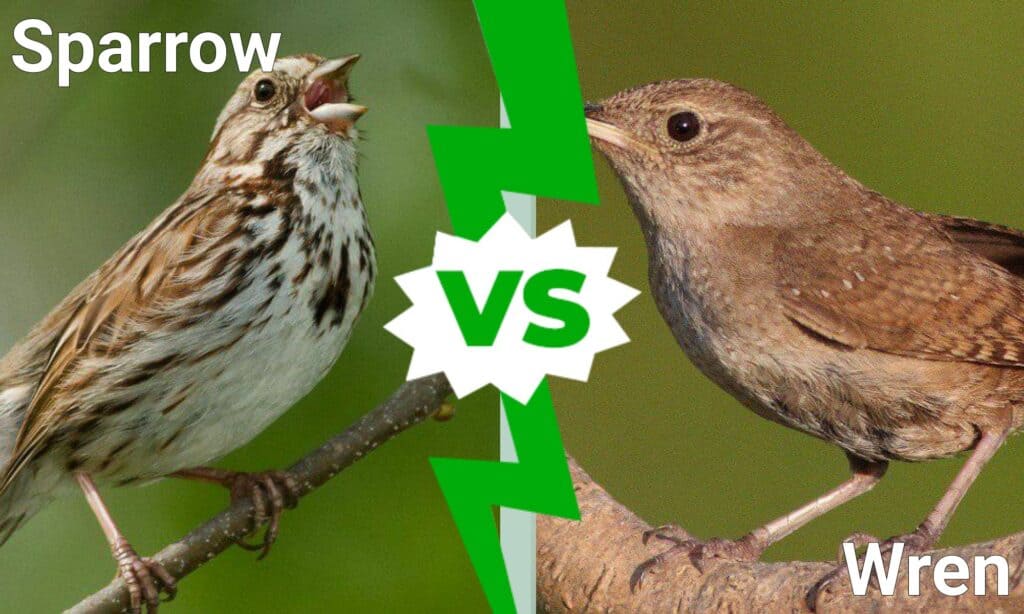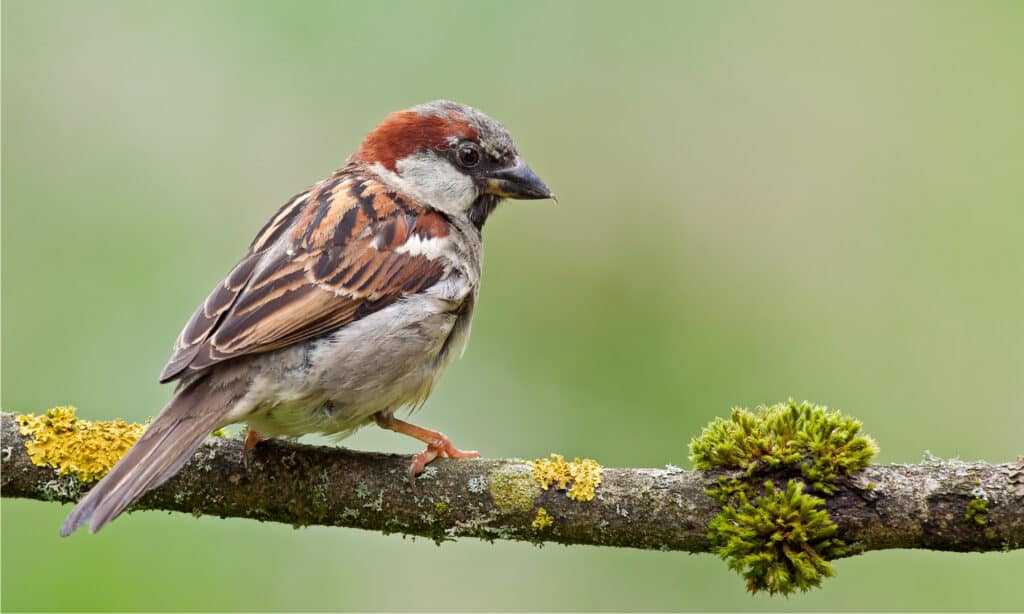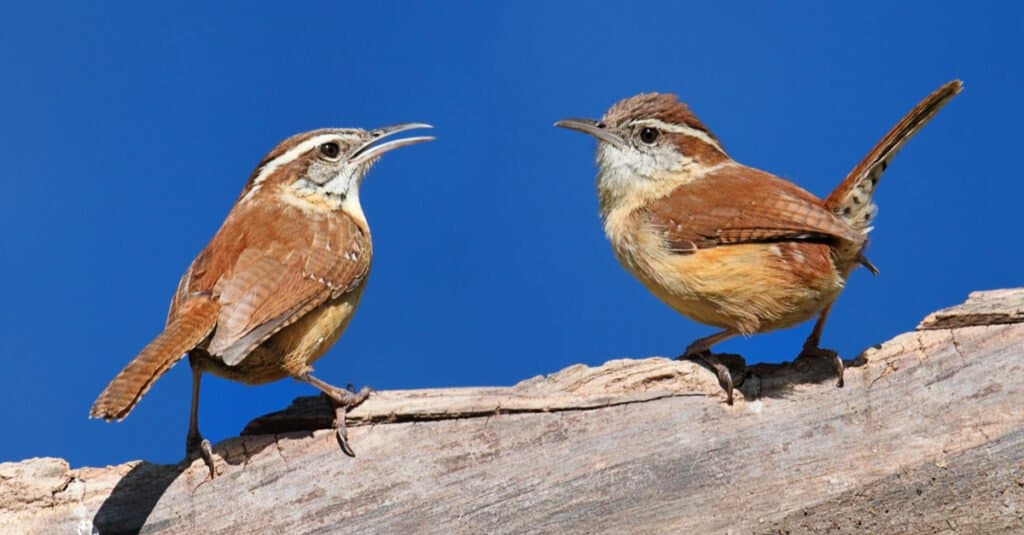Sparrows and wrens are among the most common birds you can encounter in North America. Although they are distinctly different, they are quite difficult to tell apart! Whether you are a birdwatching hobbyist or just recently put up a feeder, knowing the differences between the two can be a bit tough. Thankfully, some clear distinctions can help us separate the two. Let’s discover: Sparrow vs Wren; what’s the difference?
Comparing a Sparrow and a Wren

| Sparrow | Wren | |
|---|---|---|
| Size | 4.5-7 inches long. | 4-5 inches long. |
| Body shape | Round, although they are more slender than wrens | Rounded, squat looking. |
| Diet | Seeds | Insects |
| Eye lines | Often have caps and multiple lines | Many species have a distinct eyebrow line. |
| Common patterns | Black, white, and gray. Intricate patterning on wings and back is common. Usually have colored caps. | Eyebrow lines, light brown with speckles. |
| Bill shape | Broader than a wren. | Thin, needle-like. |
| Tail length | Short, but longer than a wren. | Short, often pointed vertically. |
| Taxonomy | Passerellidae | Troglodytidae |
The 6 key differences between a Sparrow and a Wren
The main differences between sparrows and wrens are size, diet, taxonomy, body shape, eye-line, tail length, and bill shape.
Sparrows and wrens are easily some of the most common birds that any backyard enthusiast is likely to see. As the warmer weather encroaches, these sightings become more common as the birds migrate and are more active while looking for food.
Although these birds are extremely similar in many ways, there are a few key differences. These differences can help us tell them apart and are perfect for anyone who is just getting into birdwatching or is curious about their new feeder’s visitors. The main differences between the two are physical, although they have some behavioral differences that can also help us identify them.
It’s also important to note that sparrows aren’t a single bird species. There are 35 species of New World sparrows (sparrows that live in the Americas) and more when you account for the rest of the world. Additionally, 88 species of wren live all over the world. Recognizing this, it’s important to know that there isn’t some catch-all feature or tell that allows anyone to perfectly differentiate the two.
Let’s get into some of the primary differences between sparrows and wrens in North America!
Sparrow vs Wren: Size

Sparrows are larger than most wrens.
©Elliotte Rusty Harold/Shutterstock.com
When it comes to size, the sparrow has the edge. Sparrows are slightly larger than most wrens, although both birds are quite small overall. Most sparrows are going to be 4.5-7 inches long.
Wrens are even smaller than sparrows, putting them closer to some other birds like chickadees and finches. Most wrens will be 4-5 inches long and could easily fit in the palm of your hand.
Sparrow vs Wren: Body shape

Wrens are round, puffy, and smaller than sparrows.
©brandtbolding/Shutterstock.com
Both birds have a similar body shape, although there are a few key differences. Sparrows are pretty round birds overall. Their bodies are round, and their heads are conical, but their bodies are usually longer than wrens. Sparrows are a bit less stocky than wrens are, although they aren’t the most athletic-looking birds. Overall, a sparrow will appear more slender than wrens but rounder than most other birds.
Wrens are small, squat birds that look like little puffballs. These cute birds are stockier and smaller than sparrows in almost all their features. When a wren is vocalizing, they tend to puff up even further, making them look like little balls of feathers.
Sparrow vs Wren: Diet

Sparrows mostly eat seeds, and wrens mostly eat insects.
©Rob Christiaans/Shutterstock.com
One of the most distinguishing features between the two is their diet. Although this isn’t immediately recognizable from their appearances, their dietary habits can help a discerning individual tell the difference.
Sparrows are primarily seed-eaters (granivores), making them common visitors to feeders and suets. Like most birds, however, they are rather opportunistic and will eat almost anything they can find. When food is plenty, they generally stick to seeds. Sparrows are ground foragers and can be seen hopping along the ground, looking for grains and other discarded food.
Wrens are primarily insect eaters (insectivores) that eat small insects, spiders, and other small arthropods. Like the sparrow, they will also eat other things when they can’t find their preferred foods. Some wren species are known to eat vegetables, fruits, berries, and small lizards and frogs. Still, the vast majority of wrens will prefer small insects. Wrens will occasionally visit feeders and suets when they want something a little different, however!
Sparrow vs Wren: Eye lines

Wrens often have distinctive eyebrow lines.
©Steve Byland/Shutterstock.com
Sparrows generally have caps with lines on their heads. These lines could resemble eye lines, but not in the way a wren normally will. Sparrows will usually have lines under their eyes that connect with other colors to form their caps.
Many wrens have distinct lines over their eyes that give the impression of eyebrows. The Carolina wren, for example, has distinctive white lines that go over both eyes, which is one of the best ways to identify them.
Sparrow vs Wren: Bill shape

Sparrows have thicker bills, while wrens have thin, needle-like bills.
©iStock.com/Luc Pouliot
Sparrows have a stouter and thicker bill than wrens, reflecting a sparrows diet. Cracking seeds and grains is much easier with a thicker, stronger bill. Some sparrow species have a slight curve to their upper bill, but it isn’t always noticeable.
Wrens eat insects, and their bill reflects this. The bill of a wren is thin and needle-like, perfect for quickly snatching up fast insects.
Sparrow vs Wren: Tail length

Wrens often hold their tails at a sharp angle.
©Steve Byland/Shutterstock.com
Sparrows have broad tails and are generally longer relative to size than wrens. Additionally, sparrows will flash their tails and hold them in various positions, especially horizontally.
Wrens have shorter tails but use them in flashing displays as well. The most common way for a wren is to hold its tail in an upright position. They often perch with their tails in the air while they sing.
Sparrow vs Wren: Taxonomy
Sparrows belong to the Passerellidae family. There are 138 species of sparrow across the New World, with 35 in North America.
Wrens belong to the Troglodytidae family. There are 88 species of wren worldwide and can be split into 19 genera.
Bonus: House Wrens Like to Have Spiders as Roommates

House wrens have been known to distribute spider egg sacs around their nest.
©Chloe Langton/Shutterstock.com
House wrens are known to fight other birds such as bluebirds, warblers, and chickadees for the best nesting sites – and once they land the right spot – they work to make it perfect. These industrious little birds have come up with a method to keep their chicks free of mites and parasites. They gather spider egg sacks and distribute them around the lining of their nest. When the baby spiders hatch – they eat the pests that pester the little chicks! With ideas like that – its no wonder that house wrens have the largest distribution of any songbird in the Americas!
The photo featured at the top of this post is © iStock.com/PaulReevesPhotography
Thank you for reading! Have some feedback for us? Contact the AZ Animals editorial team.






